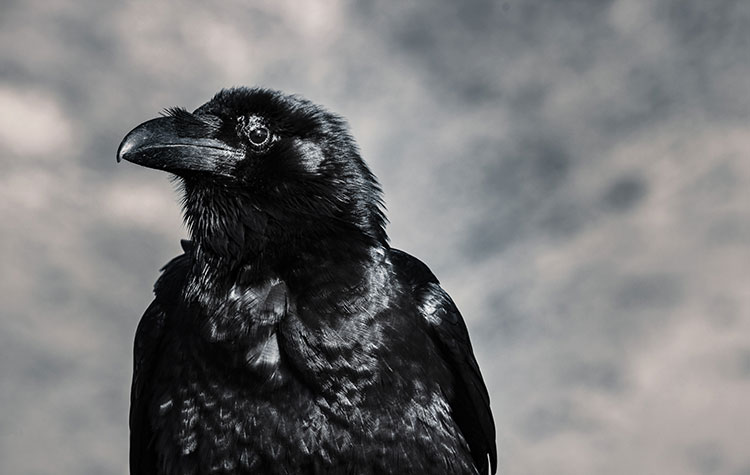
You’re in a bug out situation. Home is no longer safe. You’re waiting for danger to pass. You’re hungry, starving in fact. You hear the birds. Your mind wanders. Can you eat crow?
Yes, you can eat crow.
When one thinks of living off of wild meat, the first thought leans towards species such as whitetail deer or hunting the petite grey squirrel, but there are many other overlooked species that can be pursued for survival. Many animals keep with them a certain reputation for being “trash” or disgusting, but only because rumor and tradition labels them as such. The crow is one of the most prominent victims of these negative reputations.
Is Crow Safe to Eat?
People wrongly assume that because crows aren’t picky about what they eat that they aren’t safe to eat. Nothing could be farther from the truth; it might surprise you just how little the diet of the animal you’re eating has to do with the safety of its meat. Eating crow will not make you sick as long as you take the proper precautions and preparations to preserve the quality of its meat.
The truth is, not only is crow safe to eat, but there was a period in U.S. history when eating crow was all the rage. Consider this (source):
In 1936, the residents of Tulsa, Oklahoma were seized with a craving for crow. Butchers sent children into the fields, offering $1.50 for every dozen crows they brought back for the chopping block. Nurses and dietitians suggested that crow-meat could become a staple food in hospitals. And Miss Maude Firth, a domestic science teacher, established a class in crow-cookery.
While there are many animals that provide a wider range of nutritional benefits, according to this website, the average crow contains around 100 calories, 1 gram of fat and 20g of protein. Harvesting an animal such as a deer or wild boar would bring you a lot more nutrition over a longer period of time, but because of how plentiful and widespread crows are, they are worth considering in a survival plan, especially if finding larger game becomes difficult. Let’s face it, everyone is going to be hunting whitetail deer during a prolonged collapse.
Crow Stigmas and What They’re Rooted In
Why are crows viewed with such a negative lens? The phrase “eating crow” being a negative expression shows just how low we think of these birds. Over the centuries, crows have been considered bad omens or as vicious creatures for a number of reasons.
Especially in literature crows and other corvids have been mainly associated with witches or other evil beings in their dark practices against the protagonist. In folklore crows are believed to be thieves that are attracted to anything shiny, or that they plunder the nests of other birds which in turn brings down their populations. When it comes to viewing crow as a meal, people often will dismiss it based on the fact that they see their neighborhood crows dining on garbage and roadkill and other “nasty” foods.

Another issue people have with crow is that it seems whenever you hear that someone has actually tried it, it tastes nasty and isn’t “worth the effort.” As with most wild game, poor meat preparation and handling is critical to the recipe. That starts the moment the animal is harvested. Read on to find out how you can prevent the meat from spoiling and ensure a good tasting meal.
Crows actually have a much more diverse and varied diet, which includes the eggs from many bird species. Their diet often ranges from a wide array of grains, fruits, nuts, berries to insects and larger animals. They are also known to eat aquatic animals like fish, turtles, clams, and crayfish. This is a very nutrient-dense diet that isn’t found in many of the more charismatic conventional prey species.
3 Ways to Procure Crow Meat
Now that you’ve overcome the stigma over eating crow, you can think about overeating crow. But how are you going to get one into your cast iron skillet?
When you’re in a possible SHTF situation where there are no governing agencies limiting how many crow you can take, the only limitation to procuring crow is how creative and in tune you are with crow behavior. Until some survival situation, collapse situation hits, you’ll have to do your own research on the limitations to legally hunting crow. However, because farmers and others view crows as a nuisance, most states have very liberal bag limits and long seasons to help keep the prolific bird’s population from exploding out of control.
Trapping
Most information you will find when researching how to hunt crows will be based around how to hunt with a shotgun, and because of the legal restrictions from game and fish agencies, practicing other ways to obtain crow meat before a survival scenario will be limited. But if you find yourself without a weapon and need to obtain a crow for dinner, you will most likely need to lure one in with a trap.
Crows are extremely intelligent and can even teach several generations of their offspring to avoid your presence. You will have to be careful and incredibly creative in order to dupe these clever birds. There are commercial traps that you can purchase (such as this one), but there are also a plethora of bushcraft traps that you can learn to make.
Crows and Owls
For whatever reason crows and owls have an ongoing feud, so much so that whenever a crow even sees an owl the entire murder will band together to divebomb them. You can take advantage of this by using an owl decoy in your spread to incite a frenzy.
Throwing Sticks or Stones
Probably the simplest (and most ancient) way of procuring bird meat is the use of a throwing stick, rock, or bola. People may have their own moral quandary with whether a technique is considered to be humane or not, but in a survival situation you will not care. Many times, when using a thrown weapon, it will not be an instant kill so you will have to follow up with a death blow or wring its neck.
You can practice by throwing sticks and stones at targets at different ranges so that when you see an opportunity, you can take it.
Shotgun
There is a reason that humans have been so incredibly successful in pursuing animals and birds of all types since the invention of firearms. Shotguns provide the most simple way for anyone to bring down crows because of how often you will find them flying and out of reach. Crows can fly fast, but not faster than lead shot. In fact, the shotguns wide spread of pellets is one reason shotguns could be the ultimate SHTF firearm.

When hunting crow with a shotgun, a popular and effective strategy is to set up on the edge of a field where you can hide under some natural cover but have easy access to the sky. Set up a few decoys and utilize either an electric or mouth-blown crow call. In theory, the crows will be lured in by the sound of rivaling crows, see the decoys, and swoop in close to see what’s going on which will give you plenty of shot opportunities.
Crow Processing and Meat Safety
Once you’ve killed a crow, how do you process it? There are more than one ways to skin a cat, and there are more than one ways to process a crow. You can always pluck it like you would a chicken or turkey to try and preserve the skin and keep some of the nutritive fat that sits within and underneath it.
The most popular way to process crow is to remove the breasts and legs exclusively. Crow Busters not only has a good description of the process but also several recipes (I will give you the easiest recipe in a bit).
The other consideration you will have to take is to be careful when handling the meat itself, especially when temperatures are reaching anything above 45 degrees Fahrenheit. The chances of you getting food poisoning increase if you are unable to get the meat cooled after harvesting. You don’t necessarily have to utilize a cooler system when transporting the meat if you don’t have one, just be sure to utilize shade and cool moving air to help keep the meat cool.
There are also possibilities, small possibilities, that you can get a disease from a crow. If you’re concerned about this, wear gloves when handling the carcass and always wash your hands before you eat.
Preparing Crow
According to what I have read and researched, crow is very similar to duck in both flavor and ideal preparation styles. If you want a safe option that will allow you to stomach the bird’s meat when you’ve harvested one but are still apprehensive about it, a simple stew or soup is probably the safest bet since you can hide the flavor a little amongst the other ingredients.
In a survival situation a stew or soup is also an incredibly smart move because the act of making the soup will pull out the maximum amount of nutrients from both the meat and the other ingredients you use and infuse it in the broth which will help you fight off illness and keep your body strong. You can hold onto the bones and extra meat from the unused carcasses to use in making bone broths and stocks to improve their nutritive value.
Simple Crow Recipe
My friend in the “102” feature photo cooks his crow like partridge: flour, cornmeal, salt, pepper, and butter. He said it tastes like dark meat, much like woodcock. That is perhaps the simplest recipe, fry it up and enjoy!
Can You Eat Crow Conclusion
Hopefully reading this article has at least challenged the old wives’ tales of what is and is not edible, even if you still don’t eat crow. It’s too easy to overlook or forget all the ways that the land, animals, and plants that surround us can help us live full, healthy lives and – especially – survive.
Using crows as a food source, even if it’s just for survival, poses a potent example of how creativity and keeping an open mind is a crucial concept to hold onto in order to make the most of our time on this earth, in both times of plenty as well as when things get rough.
Who knows, maybe you’re even now considering having crow for dinner. If you do, let us know in the comments what you thought of it.

3 comments
Crow is a might on the ‘gamy’ side, in taste, but with a little seasoning it’s not too bad. In a SHTF situation you will have to look at any and every possibility when food is scarce. You’ll have to make do with what there is, that is, ‘if’ it’s truly edible.
Crow is no more “gamy” than almost all wild birds. They are “gamey” compared to T.V. dinners etc. Why would you use seasoning to hide the taste, as that is what is good. And of course it is “truly edible”.
Crow is plentiful, nutritionally safe, excellent survival food, with no one else eating it, there will be plenty